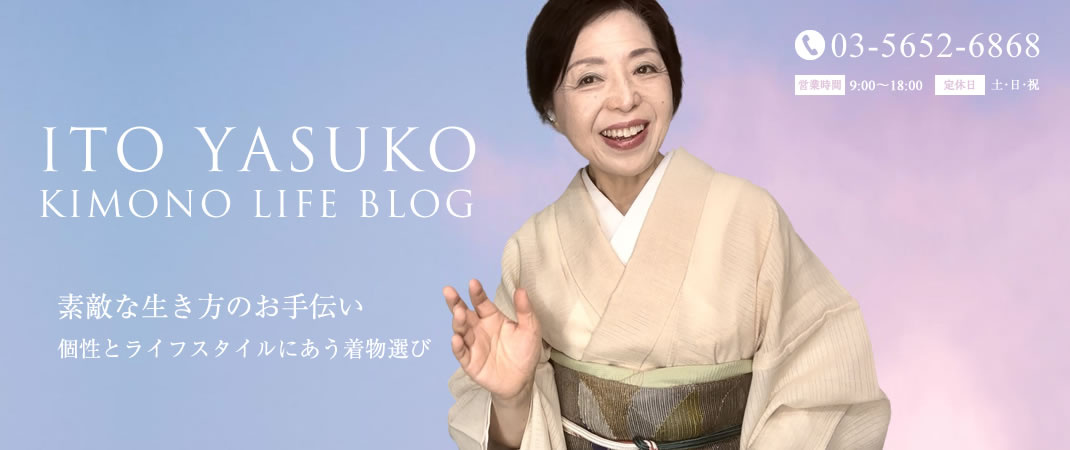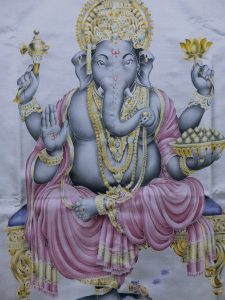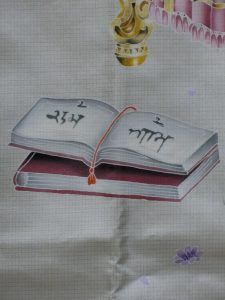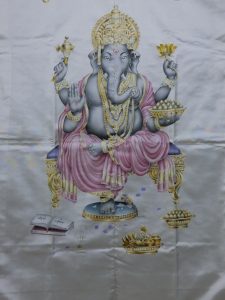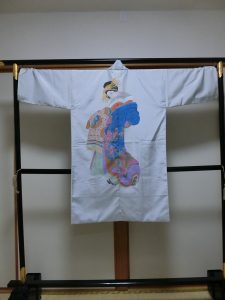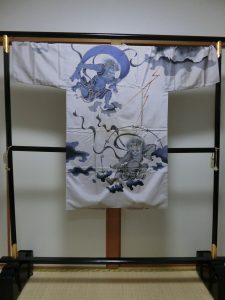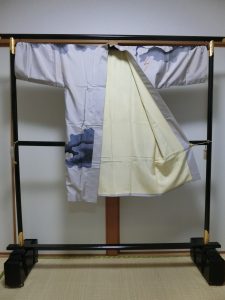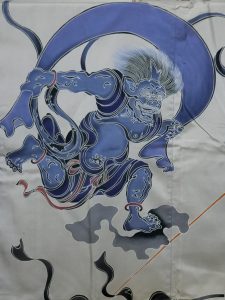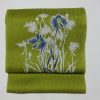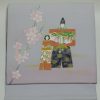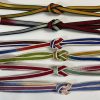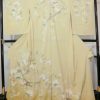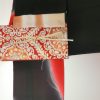絹の大島紬に後染めした、大変美しい半纏で、仕立て上がっていますからすぐにお召しいただけます。
風神雷神、女郎、ガネーシャ、鯉の滝登りの4枚です。半纏は、お袖がお洋服のような筒袖です。
日本の国を代表する糸目友禅作家の滝沢晃先生が染めた作品です。
https://kimono-bito.com/z-30530tenjikai/3.php
「糸目友禅」という、日本の染め技術の中でフォーマルなお着物を代表する
手仕事で染色加工で染めています。
ホテルやパーティのような場面でも、光沢感があり男女兼用で素敵にお召しいただけます。
This is a very beautiful hanten dyed with silk Oshima Tsumugi. It is ready to wear as it is tailored.
Fuujin Raijin, Joro, Ganesha, Koi climbing a waterfall
These are four pieces. The hanten has sleeves like Western clothes.
These pieces were dyed by Akira Takizawa, a representative Itome Yuzen artist of Japan.
https://kimono-bito.com/z-30530tenjikai/3.php
Itome Yuzen is a Japanese dyeing technique that represents formal kimono
It is dyed by hand using a dyeing process.
It has a glossy finish and can be worn by both men and women, making it a great choice for occasions such as hotels and parties.
□半纏とは
半纏(はんてん)とは、江戸時代に庶民の間で着用されるようになった防寒着のことで
今ではお祭りの際に羽織っているものがイメージしやすいです。
半纏の特徴は以下のとおりです。
・羽織に近い形状
・袷(表地と裏地の二重)がある
・綿入り半纏は袷の間に綿が入っている
・袖丈は五分くらい
半纏の元々の由来は、袖が半分という所から「半丁(はんてん)」と呼ばれていて、そこに
「纏う(まとう)」という意味がプラスされて半纏(はんてん)と書かれるようになったそうです。
この半纏は、絹に染めていることと、日本を代表する糸目友禅作家さんの高い技で描いたオリジナルの絵柄がポイントです。
それだけ格が高く上質なので、そのような場面でお召しいただけます。
□What is a hanten?
Hanten is a cold weather garment that began to be worn by common people during the Edo period.
It is easy to imagine it being worn during festivals.
The characteristics of a hanten are as follows.
・It has a shape similar to a haori.
・It has a double layer (outer and lining).
・Cotton-filled hanten have cotton between the layers.
・The sleeves are about five minutes long.
The original name of the hanten was “hanten” (half-length hanten) because the sleeves are half-length, and the meaning of “to wear” was added to it, so it came to be written as hanten.
The key points of this hanten are that it is dyed silk and the original pattern drawn by a leading Japanese Itome Yuzen artist with high skill.
It is of such high quality that it can be worn in such situations.
□半纏ガネーシャ 新しい始まりや事業の成功
ガネーシャはヒンドゥー教の神々の中で、運の神や知恵の神、障害を取り除く神として崇拝されています。
彼は象の頭を持つ姿で表現され、特に新しい始まりや事業の成功を祈る時に敬われます。
Ganesha is worshipped in the Hindu pantheon as the god of luck, wisdom and the remover of obstacles.
He is depicted as an elephant-headed figure and is especially revered when praying for new beginnings and success in business ventures.
・・・・・・・・・・・・・・・・・・・・・・・・・・・・・・
□半纏女郎 江戸時代のお金を得る重要な手段
女郎とは、江戸時代の日本において、遊郭で働く女性のことを指し、特に高級な身分であることが多かったのです。
女郎は、客をもてなすだけでなく、お金を得る手段としても重要な役割を果たしていました。
明治時代以降、女郎の存在は少なくなり、風俗が変化していったため、その文化は歴史的なものとなりました。
In Japan during the Edo period, the term “joro” referred to women who worked in brothels, and they often were of particularly high social status.
Joro not only entertained customers, but also played an important role as a way to earn money.
After the Meiji period, the number of jorō decreased and customs changed, so the culture became a historical thing.
・・・・・・・・・・・・・・・・・・・・・・・・・・・・・・・・・・・・・・・・・・・
□半纏鯉の滝登り
鯉の滝登りは、中国の伝説に由来し、鯉が滝を登り切った際に龍になるとされる成長の象徴です。
この伝説は日本の文化や習慣に影響を与え、端午の節句では鯉のぼりを飾ることで子供の成長を願います。
鯉の滝登りは、家族の健康や出世を祈る象徴的な行事として、多くの地域で祝われています。
The carp climbing waterfall originates from a Chinese legend in which a carp becomes a dragon when it reaches the top, symbolizing growth.
This legend has influenced Japanese culture and customs, and on Boys’ Festival, carp streamers are displayed to pray for the healthy growth of children.
In many regions, the carp climbing waterfall is celebrated as a symbolic event to pray for the health and success of family members.
・・・・・・・・・・・・・・・・・・・・・・・・・・・・・・・・・・・・・・
□半纏風神雷神「恵みの風と雨」
風神雷神図(ふうじんらいじんず)は、風袋から風を吹き出し風雨をもたらす風神と、太鼓を叩いて雷鳴と稲妻をおこす雷神の活動の姿を描写する絵画です。 」
風神・雷神(ふうじん・らいじん)とは、「恵みの風と雨」をもたらす神様です。
もともとは古代インドの神さまであり、風と雷をつかさどる神として信仰されていました。
日本では仏教の守り神である天部とされ、恵みの風と雨をもたらすといわれています。
風の神(妖怪)である風神と、雷の神(雷様)である雷神を描いたもので最も有名であると思われるのが、俵屋宗達による「風神雷神屏風」です。
絵自体に落款や印章もありませんが、のちに尾形光琳など多くの画家に模写された、俵屋宗達の最高傑作との呼び声高い屏風絵です。風神と雷神を左右遠く離した位置に描き、金地の余白部分を天空とみなしたその描き方は宗達の絵画構成の真骨頂とされています。
現在では建仁寺が所蔵しており、国の重要文化財に指定されています。
風神雷神屏風絵は、日本国内外を問わずデザインとしても人気が高いものです。
The Wind God and Thunder God paintings depict the activities of the Wind God, who blows wind from a wind bag to bring about wind and rain, and the Thunder God, who beats a drum to create thunder and lightning.
The Wind God and Thunder God Screen by Tawaraya Sotatsu is probably the most famous painting of the Wind God, the god of wind (a monster), and the Thunder God, the god of thunder (a god of thunder).
Although the painting itself does not bear any signature or seal, it is highly regarded as Tawaraya Sotatsu’s masterpiece and was later copied by many artists, including Ogata Korin. The Wind God and Thunder God are painted far apart on the left and right, and the blank space on the gold background is considered the sky, which is said to be the essence of Sotatsu’s painting composition.
The Wind God and Thunder God Screen paintings are currently owned by Kenninji Temple and have been designated as an Important Cultural Property of Japan.
The Wind God and Thunder God Screen paintings are popular as designs both in Japan and overseas.
・・・・・・・・・・・・・・・・・・・・・・・・・・・・・・・・
生地は、大島紬の白生地を染めています。
つまり表地も裏地も絹です。
薄くて軽くて着やすいです。
夏も冬も羽織っていただけると思います。
張りのある生地なので、特に注意はいらないのですが
絹は虫はつきませんが、カビには注意して下さい。
私は、クレベリンを近くに置くことで対応しています。
また、男女どちらにもお使いいただけます。
また、もし汚れましたら当店で汚れた染み抜きや汗取りに対応させていただきます。
とても上手な職人さんがいます。こちらは、都度有料です。
The fabric is dyed white Oshima Tsumugi.
In other words, both the outer and inner linings are silk.
It’s thin, light, and easy to wear.
I think you can wear it in both summer and winter.
It’s a taut fabric, so you don’t need to be particularly careful.
Silk doesn’t attract bugs, but you do need to be careful of mold.
I deal with this by keeping Clevalin nearby.
It can also be used by both men and women.
Also, if it gets dirty, we can remove stains and sweat from it.
We have very skilled craftsmen. This is a paid service each time.
ご注文、ご質問は、<shop@kimono-bito.com>または、下記からご連絡下さい!
https://www.kimono-bito.com/inquiry.php
If you are interested, please contact us at <shop@kimono-bito.com> or via the link below!
https://www.kimono-bito.com/inquiry.php
